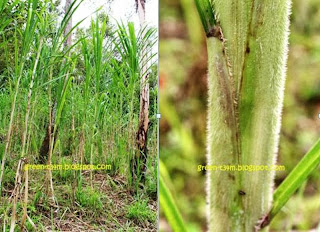 |
| Mount Melingkuh in the distance |
This is VANESSA and really nice to see you again!
My sister Patricia has written two stories about the camping and hiking we had a week ago. And now I want to write about some unique plants we found during our hike in the forest. A forest is full of plants, big and small. Some of them have many benefits and some of them must be avoided. Mr. Kadek the owner of BOF (Bali Outbond and Farmstay) provided two hiking leaders for us to learn many things about plants in the forest. It was one of the most exciting moment we have during camping. On behalf of TGTI, we would like to thank Mr. Kadek and all BOFpeople. The knowledge you share is really useful for us.
Lateng Ngiu
The name is strange. From Google, I know that the Latin name of this plant is Dendrocnide sinuata (BL.). Be very careful with this plant because if you touch Lateng Ngiu, your skin will be itchy and hot! It will last for maybe 10 days! From the hiking leader, I learn that to cure yourself from Lateng Ngiu 'sting':
 |
| Lateng Ngiu |
The name is strange. From Google, I know that the Latin name of this plant is Dendrocnide sinuata (BL.). Be very careful with this plant because if you touch Lateng Ngiu, your skin will be itchy and hot! It will last for maybe 10 days! From the hiking leader, I learn that to cure yourself from Lateng Ngiu 'sting':
- You have to wear gloves to cover your hands and fingers.
- You have to cut the youngest Lateng Ngiu's stem
- You have to peel the bark of the young Lateng Ngiu until the sap comes out
- You smear the sap on the infected skin. It makes your skin relax for a while
 |
| Rumput Gajah (Left) and the Furry Stem (Right) |
Rumput Gajah
In English, it is called Napier Grass or Elephant Grass. From Google, the Latin name of Rumput Gajah is Pennisetum purpureum. You can find Rumput Gajah in Africa. Rumput Gajah is for feeding a cow. It can be as tall as bamboo tress. The stem of the Rumput Gajah is furry but don't touch it because it can make you feel itchy. Be careful with the leaves of Rumput Gajah because it is sharp and can scratch your skin.
Kacang Ercis or Kacang Polong is a vegetable and it is very healthy for you. Kacang ercis is Peas in English. The Latin name is Pisum Sativum. It has vitamin A and vitamin K. For cooking, it is usually stirred fry or for soup.
 |
| Damar Trees |
Pohon Damar or Damar Tree
Damar is a very tall tree and can grow until 65 meters. The Latin name of Damar tree is Agathis Dammara. Damar tree is from Indonesia. It is especially planted for its resin.
Pohon Kaliandra or Calliandra Tree
Calliandra tree is for feeding the cattle in the village. The Latin name of this plant is Calliandra calothyrsus. Our hiking leaders made some sticks for us from this tree.
 |
| Calliandra Tree |
Calliandra tree is for feeding the cattle in the village. The Latin name of this plant is Calliandra calothyrsus. Our hiking leaders made some sticks for us from this tree.
 |
| Forest Coffee: fruit (left) and flower (right) |
Kopi Hutan or Forest Coffee
I don't really know about this coffee. I don't know if it is different with the coffee in the coffee plantation. So, we call it Kopi Hutan or Forest Coffee. Our hiking leader from Sumba told us how to make coffee from this forest coffee. He usually makes it in his hometown in Sumba. This is how to make the coffee from this forest coffee:
- Pick the ripe coffee fruit from the trees.
- Roast the coffee fruit on a pan without oil.
- Grind it until it is like powder. Put in a glass and pour hot water to make a glass of coffee.
From Google, Keladi's other name is Taro. In Indonesia, it is also called Talas. The Latin name of this plant is Colocasia esculenta. You can eat the roots, but you have to cook it really well. If it is not cooked well, its sap can make your tongue and throat itchy. The Keladi roots are also for feeding the pigs.
Thank you for reading.
Best Regards,
Vanessa


No comments:
Post a Comment